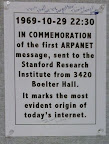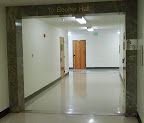Classess, and Stuff
Its been a distressingly long time since I last blogged, but thats OK because I'm the only one that cares. My numerous lamentations now aired out, we move onto the good stuff (or bad stuff, depending on your point of view...)
So this last quarter, I found my digital design course consuming an inordinate amount of time, and with each passing week the amount of time I spent in lab per day increased at a logarithmic rate (logarthmic, because there are only so many hours a person can spend in lab before there simply ceases to be hours in the day). The premise of the class was quite simple: spend the first few weeks going through cookie-cutter labs whilst learning the ins-and-outs of the tools and VHDL, and then spend the rest of the quarter builidng your own personal project on a FPGA. My group of three proposed to create a system where a user could drive an iRobot Create by mimicking driving motions in front of a camera, an idea perhaps less ambitious then other groups in the class but nonetheless quite daunting. Unlike Microsoft's super-amazing-funtastic-galactic-awesome Kinect, our system made no use of fancy infrared projectors. Instead, we simply required the user to wear blue gloves or grip a stick tipped in blue, and place their foot over a piece of green cloth. Take a look at our demo:
You'll notice also, that on the disply we drew solid bounding boxes over the blue and green objects in the frame.
This was done almost entirely on the FPGA and was written in VHDL, with only communication over serial port handled by the PPC405 CPU. So yeah, it took a really long time.
Dollhouse at the NSA
Over the previous summer, I rediscovered Angel and Buffy the Vampire Slayer and watched some old episodes at hulu. (And let me just say, think you hulu for throwing my resume aside so nonchalantly after you read the second line. Electrical engineering major I may be, but I know RoR, SQL, Unix C, and just as much crap as any other CS guy out there.) Anyhoo, some of you Joss Wheedon fans may have heard that Wheedon has a whole new series out by the name of Dollhouse, not nearly as popular as some of his other shows, but still pretty cool. Or at least it started out cool, lately, its just been getting a little kinky and weirdish.
But I digress, I'm not here to discuss the merits of Dollhouse (I'll save that for another time) but rather to point out a few odd little facts about episode 9 (A Spy in the House of Love). Theres a part in episode 9 where Sierra knocks out some Japanese chick on a train, steals her identity, and walks into some big NSA facility. Now as I was watching Sierra traipse through the sparse halls of the NSA, I had a strange feeling of deja vue. But it wasn't until the part where she checks in with a security guard to access some giant government database, that I realized what I was seeing: the building that they used for the NSA in episode 9 was none other then UCLA's infamous Boelter Hall, (aka my third home (the first being my real home, and the second being my dorm room)) and the room that Sierra and the security guard were in was none other then Boelter 6426. I know Boelter quite well, having spent far too much of my time there (or rather, here, since I'm in Boelter right now), and I know the building's appearance right dsown to the ugly water fountains, square black digital clocks, distinctive green flecked staircases, and blocky gold door numbers.
There are of course people that still doubt me, I know. So go to hulu and watch the section from episode 9 again, and then look at these pictures that I took at 7:30 on Monday morning.
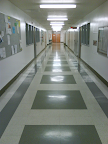 |
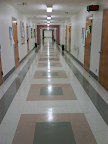 |
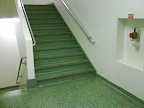 |
Request for a Change
Hauling out my change of major request essay...
Prior to UCLA my knowledge of anything vaguely associated to the field of electrical engineering was essentially nil, so it should come as no surprise when I say that I cannot for the life of me begin to remember why I chose electrical engineering as a major. And now, the more electrical courses I take, the more tiresome I find the subject matter to be. So the question I should be answering isn't "why do I want to change majors," but rather, "why did I wait till now to change?"
Over the last two years, I have trudged my way through the required introductory math and physics courses, never particularly excited by the material but always telling myself that it was going to get better when I reached the EE courses and that then, everything would be worth it. So it came as somewhat of a surprise to me, that I found the electromagnetics in EE 1 to be as unexciting as the materials in all the prerequisite courses. But after having spent the better part of two quarters convincing myself that "it was going to get better," I continued to drag myself through another uninteresting class, and during my second year, I proceeded to take EE 2, 16, 116L, 10, and 102, continually hoping that things would get better. Happily, they did.
It was during second quarter of this year while I was doing EE homework one night, that I realized that the only EE classes that I have ever actually enjoyed were the multi-departmental classes (16, and 116L) shared by the EE and CS departments, and that CS 35L (informally called “intro to Linux) was without a doubt my most enjoyable class ever. Shocked by my newfound epiphany, I stood up from my desk and declared to my roommates that I did not like electrical engineering and that instead, computer science was the field for me. My roommates were unsurprised by my sudden realization, saying that they had always noticed that I liked computers more than electrical engineering, and that the energetic mannerisms that I adopted when talking about Linux or computer architecture deeply contrasted the dull and tiresome attitude I exhibited when I approached my EE homework. Indeed, during my past two years at UCLA, I have probably spent as much time tinkering with Linux and reading essays like Neal Stephenson’s In the Beginning was the Command Line, and Fred Brooks’ The Mythical Man-Month: Essays on Software Engineering, as I have dedicated to my EE classes.
I am, however, not choosing to switch into computer science, but rather computer science and engineering since my enthusiasm for all things computer related extends below (so to speak) the software level. Now lately, numerous people have pointed out to me the similarities between electrical engineering with the computer engineering option, and computer science and engineering, and asked why I simply do not stay with EE CE. A question to which I can only respond to by saying that the differences between the two majors is quantitatively quite small (That is to say, the difference in course requirements between the two is almost negligible.), but that the content of the almost negligible difference is quite significant to me; I would much rather take a compiler class rather than another electromagnetics course.
Having now realized what subjects I enjoy the most, I am loath to continue in a major I find no pleasure in. Though perhaps over-dramatic, it would not be inaccurate to say that this change of major could have the potential to dictate my future happiness.
Celebrating the Internet
Today I celebrate the 39th anniversary of the birth of the internet with a short blog post.
On September 29th of this year (2008), Leonard Kleinrock, a professor of computer science at UCLA received the National medal of Science at the White House for his work on the developing the basic principles of packet switching. It was because of Kleinrock's early work in packet switching, that his Network Measurement Center at UCLA was selected to be the first node on ARAPNET in 1969.
On October 29, 1969, the UCLA team sent, without any great public fanfare, the first ever host-to-host message to the Stanford Research Institute. The team meant to begin by sending the word "login" but only managed to send "log" before the network died. Nevertheless, the sending of the message was still a great success and a landmark in the development of the internet.
One would think that UCLA, or somebody, would maybe post a nice plaque commemorating what is essentially the birth of the internet. But the birthplace of the internet remains almost entirely uncelebrated. Almost.
Your brave and intrepid blogger, decided to venture out to UCLA's famous Boelter Hall to see the historic site, and found a little piece of paper tacked next to a room. It read:
1969-10-29 22:30
IN COMMEMORATION
of the first ARPANET
message, sent to the
Stanford Research
Institue from 3420
Boelter Hall.
It marks the most
evident orign of
today's internet.
And just so everyone doesn't think I'm a big fat liar, I've taken a few pictures.
Its epic cool, I know.
I bet y'all are so jealous that I got to visit the birthplace of the internet...
Lightbox in Typo
A quick little explanation and demo on how to get lightbox running in Typo 4.1.1.Typo 4.1.1 uses an older version of lightbox. If you prefer to use the newer version of lightbox, then go here and download lightbox 2.0. Then, in your Typo application's public directory and overwrite the old lightbox javascript, styles, and images.
You'll also have to make sure that the theme you're using for your blog, has the necessary javascript and stylesheets included. To do this, open
/railsapp/themes/<whatever_your_current_theme_is>/layouts/default.rhtml
and ensure that the following lines of code are in your header.
<%= javascript_include_tag "typo" %>
<%= javascript_include_tag "lightbox" %>
<%= stylesheet_link_tag "/stylesheets/lightbox.css" %>
I would also like to add, that one of the javascript files needed by lightbox is massive 23kb. So if you want to keep your web page as light as possible, you may want to consider not using lightbox effects.
To use lightbox in your blog, just add the following code into the article you are posting:
<typo:lightbox src="image_link" thumbsrc="thumbnail_link" />
Here's a few examples of what lightbox can do.
"The Solid Gold Sound of the UCLA Marching Band!"
Historical Building To Be Destroyed
UCLA is the birthplace of the internet. I don't know the exact history behind all of it (hardly any of it, to be exact), but I do know that the internet is generally regarded to have begun at the University of California in Los Angeles.
The exact building where the internet began, is UCLA's Engineering 1, an extremely ugly, dilapidated old building situated behind Ackerman Grand Terminal, and between Ackerman Union and Engineering IV. There are no signs marking this historical building and the great minds that toiled inside of it to give birth to a new world, only a rather dusty and plain sign that reads “Engineering 1.” From the outside, the building appears to be quite unattractive, and from the inside even more so. Half the ceiling panels in the stairwell are missing, the corridors are dirty and crammed with miscellaneous items, including mounds of paper, old CRT monitors, and even huge metal canisters of gas. There are numerous bulletin boards covered in once-bright colors, with a few notices posted on it, some new and some quite old. It is a building that looks to have lived well past its prime, and is now simply a dirty and tired old hulk.
Which is why in a few months, the birthplace of the internet is about to be destroyed.
Maybe Al Gore will come and say good bye....
